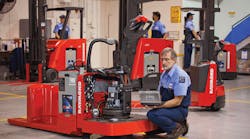Managers are often shy about justifying the size of their forklift fleet. They know this equipment is necessary to moving product but they don't always have the information needed to help them gauge asset productivity. Forklift vendors are well aware of the challenges of maintaining their products, and are providing more ways to get visibility to such information. For example, they are offering technologies for monitoring a battery's charge, discharge, water levels and temperatures.
And forklift fleet optimization systems (FOS) not only provide the basic status of batteries, but include data on forklift maintenance, impact and usage and other information affecting on-going costs.
Before managers decide to avoid uncovering the potential savings associated with their lift trucks, they should seek the answers to these questions:
- Do I have too many or not enough forklifts?
- How many hours are being put on the forklifts per shift? In a day?
- Do I have the right mix of forklifts with the right capacities and functionality required?
- How much am I spending on forklift maintenance?
- Are operators properly managing forklift batteries?
- Am I running the battery chargemeter (BDI) below 20%?
- Are my forklift batteries lasting 2,000 charge/discharge cycles?
- How and when am I charging my forklift batteries?
- At what point do I start replacing forklifts due to growing maintenance expense?
- Should I change out my older forklifts due to high maintenance costs and/or reliability issues?
- Is my vehicle checklist being filled out to ensure compliance with OSHA regulations?
- Have the credentials of operators using the forklifts expired?
- Are accidents going unreported?
- Are damaged trucks and rack uprights becoming more frequent?
- Are operators lifting loads beyond the capacity of their assigned trucks?
To understand the benefits of a FOS application we can divide the system into four categories:
- Verification of Operator Access
- Monitoring Forklift Hours
- Impact Notifications
- Tracking Maintenance Costs
Verification of Operator Access
How high are the costs associated with forklift accidents in your warehouse operation each year? Would you like to better manage the use and safety associated with your forklift activity? There are big savings from avoiding accidents causing damage to trucks and racks and injury to workers.
Most FOS packages include a verification process to ensure every forklift operator is properly set-up. An operator badge is used to scan in and out of the FOS to identify criteria such as the operator's name, the forklifts they have been authorized to operate and when their forklift license expires. Depending on the software package, this information is configured to meet customer specifications.
A FOS will allow managers total control of the OSHA vehicle checklist. These questions are completely configurable by the customer. If you already have a list of questions, enter them into the system and set the frequency to when the operator must answer these questions. The system provides the controls necessary to meet the requirements of the insurance providers. By implementing this software, the safeguards are in place to ensure that a forklift cannot be operated without signing into the FOS which identifies the operator and provides the required answers to the company's OSHA vehicle checklist. The checklist is now a document that can be printed or displayed on a monitor or printed when there is an audit by their insurance provider or by OSHA. The FOS provides 100% compliance in that the checklist is being properly filled out before the forklift is used.
Once a forklift operator has logged into the FOS, there is a complete history of the operator's forklift activity and ultimately a measurement of the person's productivity. The system will document the forklifts used, the number of hours a specific forklift remained in use as well as the hours spent traveling vertical versus horizontal. Managers will be able to track where the hours were spent on each person's shift in order to rate their productivity. The system has been designed to show when an operator tried to log into a forklift when his certification has expired and sends an e-mail to the operator's supervisor and safety manager alerting them of certifications that are due to expire. Managers can customize this feature according to the people who will get the e-mail and the time when the alert will be sent to allow enough time for the operator to attend another training course. A safety feature of the FOS is the ability to track by operator the number of impact warnings and actual impacts for a designated period.
Monitoring Forklift Hours
Is the wrong mix of lift trucks in your fleet leading to costly annual repairs and/or lower operator productivity?
The FOS will provide information by operator, so managers can see the breakdown of hours each department is putting on each forklift. If the average use of a forklift is not between 80 to 85%, then managers need to question what can be done to increase the number of hours to improve the efficiency of each forklift. Managers can study the numbers to formulate the questions needed to ensure they have the right number and mix of forklifts.
Impact Notifications
Too many times, accidents happen in the late hours of a night shift when nobody is around. Managers walk into the facility the next morning to find pallet rack uprights have been buckled. Or worse, the forklift maintenance manager comes to report that one of the forklifts needs $3,000 of work before it can be used again. All of this is without accident reports or understanding of what caused these expenses. A FOS provides this understanding and visibility when otherwise there is no evidence. Empowered with this information, the manager can quickly resolve the issues and control the resulting expenses.
An 'impact system' allows the manager to set impact ratings in 'G-force.' The manager will be able to set-up an impact warning and an event rating. Once an operator signs onto the system, the system will record if that operator runs into something that has a force impact. If an operator hits something and it falls into the rating set for an impact warning, an e-mail will be sent to designated people. This usually includes the operator's supervisor, safety manager and the facilities manager.
As a result, for example, the safety manager will review the impact area and conduct interviews.
The safety measures may include taking the operator for drug and/or alcohol tests as soon as the incident takes place. Understand, the FOS works according to rules established by the management team.
Tracking Maintenance Costs
Running your lift trucks into the ground can actually cost you more than leasing or purchasing a new vehicle. The last feature of the FOS is designed to show where the forklift and maintenance budget dollars are spent. This portion of the program tracks battery life, repairs done on each forklift by date and time, a list of parts that were used to repair the forklift and the repair technician's notes which detail the forklift's issues. Managers are able to review the forklift inventory and determine which forklifts are spending more time in maintenance as well as the maintenance expense for each forklift. This information is critical to determining when it is no longer cost effective to continue to repair a forklift and budget for the replacement of the forklifts nearing their end of life. If the forklift inventory is leased, the FOS provides the manager the detailed maintenance records to justify the replacement of the forklift by the leasing company.
The FOS provides support for the manager to justify replacing forklifts and to keep the budget in line.
In addition, the FOS allows managers to determine if a specific part is continuously being replaced. If so, the manager can negotiate with the forklift provider and request information that shows this failure is due to issues with the part itself. This could lead to no charge on the replacement of that part. When a forklift provider is notified of an issue, they can research it and help to resolve persistent downtime.
A FOS can help managers control expenses by making better decisions about keeping certain forklifts based on maintenance costs. When it is time to make budget decisions, the manager can ensure the right amount of money is allocated to keep the fleet operational and to maximize productivity. Managers can explain spikes in forklift costs by showing impacts that have taken place or maintenance costs due to operating error. They can then show steps taken to help resolve these issues so they are less of a problem going forward. Managers can also show the hours used by each forklift and make a solid case for growing or shrinking the fleet.
Forklifts are often one of the largest capital expenses for new warehouse projects. They can also represent one of the top operating costs. It makes sense then, to consider fleet management tools to get a better handle on their performance.
Norm Saenz Jr. is managing director and Steve Sepmoree is a senior consultant at St. Onge Company, a York, Pa.-based consulting firm specializing in planning, engineering and implementations related to warehousing, manufacturing and logistics operations (www.stonge.com).




